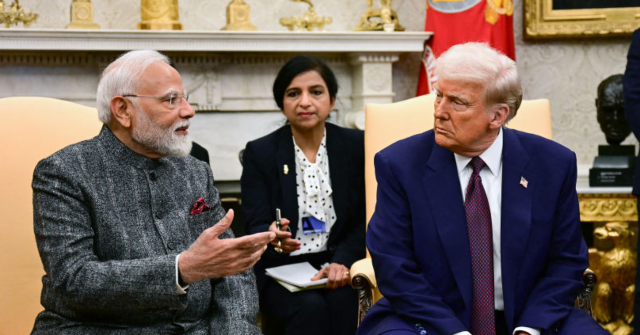President Donald Trump told reporters on Monday that his administration is close to finalizing a trade deal with India. India hedged its bets last week by notifying the World Trade Organization (WTO) that it could impose up to $724 million in retaliatory tariffs against American goods if a trade deal is not reached.
“We are doing better than ever,” Trump told reporters on Monday while meeting with Israeli Prime Minister Benjamin Netanyahu at the White House. “We’ve never had numbers like this. We’ve never had investment like this.”
Trump said his administration has “more than 90” trade proposals on the table.
“Now we’ve made a deal with the United Kingdom. We’ve made a deal with China. We’re close to making a deal with India. Others we met with and we don’t think we’re going to be able to make a deal. So we just send them a letter,” the president said.
The “letter” in question, according to Trump, would cordially invite nations that did not make a deal to continue doing business with “the greatest, most successful country ever,” provided they are willing to pay much higher tariffs.
“We’re sending out letters to various countries telling them how much tariffs they have to pay. Some will maybe adjust a little bit, depending if they have a cause,” he explained.
“We’re not going to be unfair about it, and actually it’s a small fraction compared to what we should be getting. We should be, we could be asking for much more,” he said.
The list of countries that have received those “sorry, we couldn’t make a deal” tariff letters currently includes Thailand, Myanmar, Bangladesh, South Africa, South Korea, Malaysia, Kazakhstan, and Japan.
The new tariffs are scheduled to take effect on August 1, so there is still a little time for those countries to avoid the higher levies by changing their trade policies. If they do not make a deal, the 14 countries will face tariffs from 25 percent for Japan and South Korea and up to 40 percent for Myanmar and Laos.
“We’re going to be very busy over the next 72 hours. President Trump is going to be sending letters to some of our trading partners saying that if you don’t move things along, then on August 1, you will boomerang back to your April 2 tariff levels, so I think we’re going to see a lot of deals very quickly,” Treasury Secretary Scott Bessent said on Monday.
The Indian negotiating team, which returned home from Washington on Friday after a week of meetings with their U.S. counterparts, reportedly sought a “mini trade deal” that would be good enough to hold tariffs at bay for a bit longer, until the more delicate issues can be worked out.
India — which saw 25 percent tariffs imposed on passenger vehicles, light trucks, and auto parts in March — wrote a letter to the WTO on Thursday that claimed Trump’s tariffs violate the 1994 trade agreement at the heart of the World Trade Organization.
India calculated the U.S. tariffs would affect nearly $2.9 billion worth of imports to the United States, for a total of $723.75 million in duties, so New Delhi would impose “an equivalent amount of duty collected from products originating in the United States.”
India previously informed the WTO that it plans similar retaliatory tariffs for steel and aluminum. Even as it made those preparations for retaliation, India has been among the most enthusiastic participants at Trump’s negotiating table.
This was somewhat surprising to trade analysts, because India has traditionally been stubborn about keeping its own tariff walls high while the U.S. responded with piecemeal tariffs and regulations for years. India’s cooperation with the United States on technology and defense has increased dramatically since the first Trump administration, but trade has been a sticking point until now.
“Delhi is ready to negotiate because it sees an even bigger geoeconomic play: undercut China’s status as a leading manufacturing hub and destination for investment by securing key supply chains and investing in advanced technologies,” The Diplomat suggested on Tuesday.
India’s steel tariffs grab a lot of headlines, but agriculture might be a bigger hurdle for negotiators from Washington and New Delhi to overcome. Nearly half of the Indian workforce is involved in agriculture, so the government of Prime Minister Narendra Modi would face blistering criticism if it does not protect that sector of the economy.
An Indian government official confirmed to the Indian Express on Tuesday that agriculture is indeed the greatest hurdle remaining to a major trade deal. The official said that, for the moment at least, India has “adopted an unwavering stance on this sector.”
A path forward could include greater cooperation between the U.S. and India on mineral and pharmaceutical supply chains, industries where both countries are uncomfortably dependent upon China for raw materials, plus a promise of greater investment and more technology transfers from the United States, freeing India from turning to Beijing for technology and capital investments.
Read the full article here


